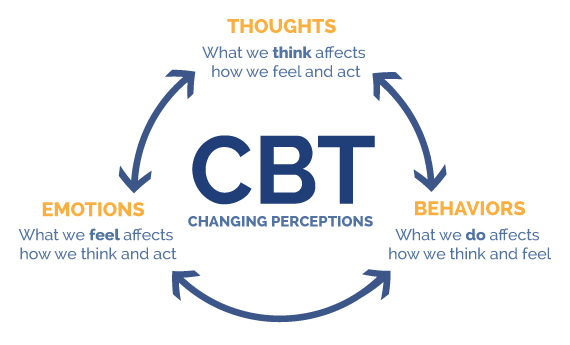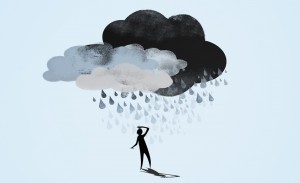The Depressive Realism theory argues that those who are depressed have a more accurate and realistic view of reality than those who are not depressed. But how should this theory inform the way we think about, and treat, depression?

Michela Clarke
EDIT Lab placement student
History of the Depressive Realism Hypothesis
The depressive realism hypothesis was developed by two researchers, Alloy and Abramson in a 1979 experiment. One of the aims of Alloy and Abramson’s experiment was to test the learned helplessness theory, which had been proposed by the American psychologist Martin Seligman in 1975. Seligman suggested that depression is the result of the perceived lack of control a person has in the outcome of situations. According to this theory, people who are depressed believe they are powerless to change the outcome of a situation. As a result, they often underestimate the amount of control they have in a situation. Alloy and Abramson’s 1979 experiment tested this theory and found that depressed individuals were actually more accurate at reporting their level of control in a situation. The depressed participants did not underestimate their level of control like Seligman had theorised, instead they were better at inferring their influence over a situation than the healthy sample.
Implications of their findings
Alloy and Abramson’s Depressive Realism hypothesis goes against what is generally thought about people who are depressed. Before this experiment, researchers theorised that depressed individuals hold negatively biased perceptions. This means that people who are depressed pay more attention to negative information and bad experiences than positive information and good experiences. For example, if a person with depression fails their driving test, they might blame themselves and attribute their failure to the fact that they didn’t practice enough. In this scenario, the person with depression may have ignored other factors, such as the weather conditions that day, that could have affected the outcome of the test. Alloy and Abramson’s Depressive Realism hypothesis meant that depressed individuals were not seen as holding negative biases, but were in fact better able to accurately infer their level of control over the outcome of a situation than non-depressed individuals. For example, they would be better at admitting that while they did not practice enough, it probably was not entirely their fault that they failed the driving test. In such cases as the driving test, Alloy and Abramson believed the depressed person would include a series of factors when identifying the cause of their failure.
“The Depressive Realism hypothesis also calls into question the basis of treatments for depression.”
 The Depressive Realism hypothesis also calls into question the basis of treatments for depression, such as Cognitive Behavioural Therapy (CBT). CBT is based on the idea that people who are depressed have negatively biased perceptions of situations. CBT then works to create a more positive perception of the event.
The Depressive Realism hypothesis also calls into question the basis of treatments for depression, such as Cognitive Behavioural Therapy (CBT). CBT is based on the idea that people who are depressed have negatively biased perceptions of situations. CBT then works to create a more positive perception of the event.
If Depressive Realism holds true, then people suffering depression do not have this negative bias, and if Depressive Realism is to believed, then people who are depressed have a more objective ability to asses a situation than a healthy person. So then we must consider, how does CBT work to help depressed individuals? Based on the assumptions of Depressive Realism, then certain aspects of CBT may not be effective when treating depression.
Methods used by Alloy and Abramson
“The contingency judgement task used in Alloy and Abramson’s experiment seems over-simplified.”
By taking a look at the methods used by Alloy and Abramson when they founded the Depressive Realism hypothesis, we might start to question the validity of this concept. Alloy and Abramson used a contingency judgement task in their experiments. This required the participants to report the amount of control they had over the results of a task. The participants’ task was to choose whether to press a button. After this choice was made, the button would or would not light up green. When the task finished the participant was asked to rate how much control they had over the illumination of the light. This meant they were reporting whether their decision to press the button had an impact on the illumination of the light, or whether the light would have been illuminated despite them pressing the button. They found that the depressed participants were more accurate in their rating of their contingency over the outcome of the task than the healthy participants. The healthy participants demonstrated an “illusion of control” , this is a bias that makes us assume we have control over situations in which we have no control (i.e. the healthy participants thought they had more control over the light illuminating than they did).
In the cartoon above the child displays an “illusion of control” over the fate of this plant. In this example the child mistakes the amount of control he has, forgetting the weather.
Weaknesses of this method
The contingency judgement task used in Alloy and Abramson’s experiment seems over-simplified. It does not reflect the inferences that people make on outcomes of situations in real life. In the task, the participants reported whether they had an influence over the illumination of a light. Having to decide whether you have influenced a light turning on is very different from the inferences made in real-life. If we use the example from before of failing a driving test, there are many more variables to consider when trying to infer how much influence you have in this result. You might attribute your failure to the road being wet, or the test being during rush hour. We cannot know for certain whether we had an influence on the failure of the driving test, or if we did, to what extent we had an influence on our failure. In contrast, in the experiment there was one correct answer to whether the participant had caused the illumination of the light. In this way, the experiment does not seem to reflect the many variables that exist in real-life when deciding how much control you have over a situation.
Conclusions
Due to the issues associated with the methods of Alloy and Abramson’s experiment, it is difficult for me to conclusively say that Depressive Realism is a good theory for understanding depression. The issues with validity of the experimental design, and the strong evidence for the success of CBT, suggest a need for more research into the perceived control that depressed individuals have over situations in real-life.


